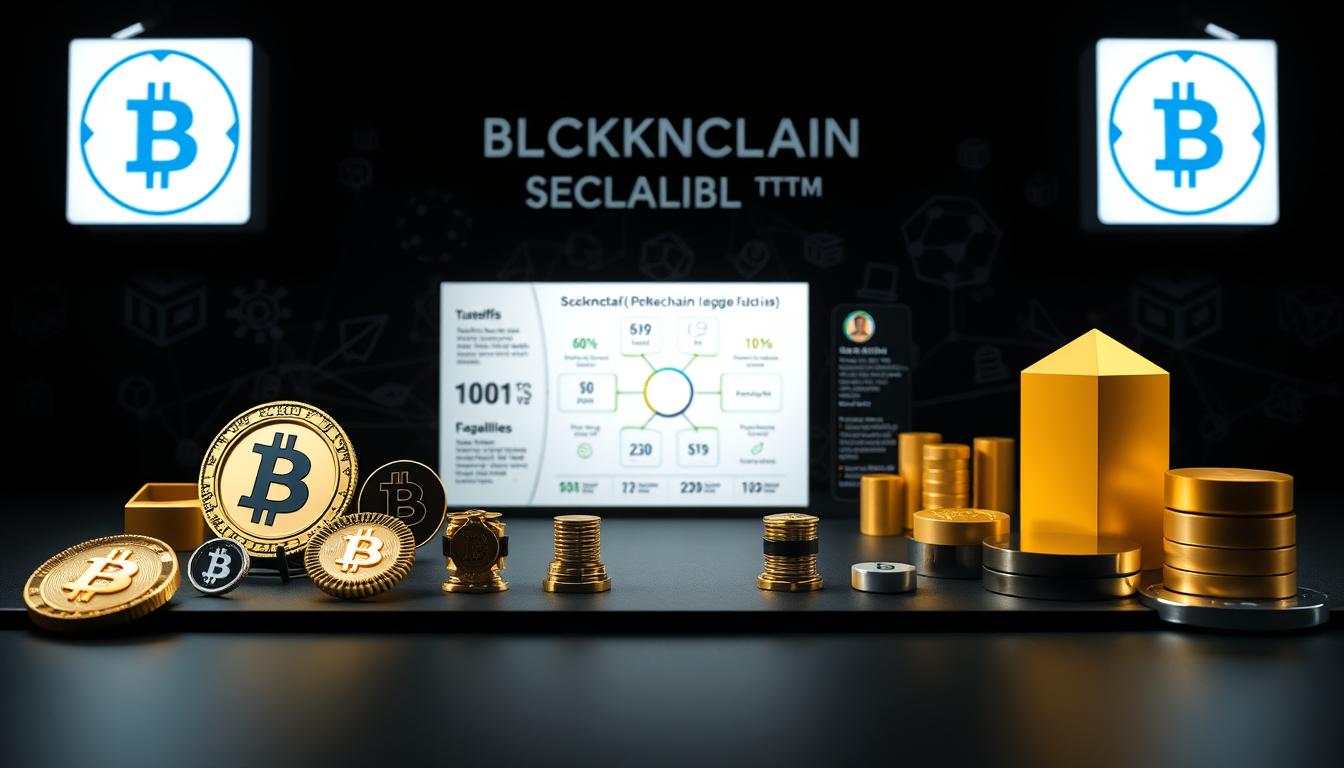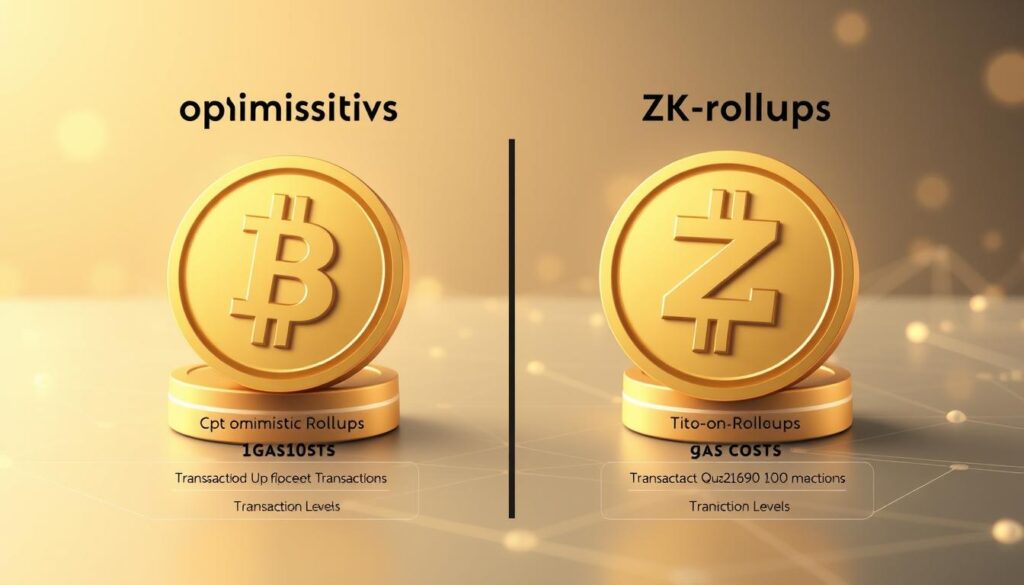Now Reading: Optimize Your Blockchain with the Best Scalability Solutions
- 01
Optimize Your Blockchain with the Best Scalability Solutions
Optimize Your Blockchain with the Best Scalability Solutions

As digital networks grow, the demand for faster transaction speeds and higher throughput pushes decentralized systems to their limits. Organizations now face a critical challenge: maintaining efficiency while handling millions of users. Without proper upgrades, delays and high costs can undermine even the most promising platforms.
Leading projects tackle these hurdles through innovative methods. Layer-2 protocols like Rollups bundle transactions off-chain, while sharding splits workloads across smaller groups. Consensus upgrades, such as proof-of-stake, reduce energy use and accelerate validation. Each approach has trade-offs—some prioritize speed, while others focus on security or decentralization.
Real-world metrics reveal stark differences. For example, networks using optimized validation mechanisms process 10–50x more transactions per second than traditional setups. However, achieving this requires balancing technical complexity with user accessibility. This guide breaks down how top-performing systems address these challenges, helping you identify strategies that align with your operational goals.
Key Takeaways
- Scalability directly impacts user experience and network adoption rates
- Layer-2 solutions and consensus upgrades offer distinct performance benefits
- Transaction throughput varies widely across different scaling methods
- Security and decentralization often compete with speed enhancements
- Real-world data shows measurable improvements in leading networks
Understanding Blockchain Scalability Fundamentals
Blockchain networks face critical challenges as adoption grows. This section breaks down why scalability remains a make-or-break factor for distributed ledgers and explores the fundamental tradeoffs developers face.
Why Scalability Matters in Distributed Ledgers
Early blockchain systems revealed hard limits. Bitcoin’s 7 transactions per second (TPS) ceiling and Ethereum’s network congestion during NFT booms exposed three critical issues:
Transaction Throughput Limitations in Early Blockchain Systems
Proof-of-Work consensus created bottlenecks. Bitcoin processes 4-7 TPS, while Visa handles 24,000. This gap makes everyday payments impractical on base-layer chains.
Network Congestion and Gas Fee Challenges
Ethereum’s 2021 peak gas fees reached $200+ per transaction. Users faced impossible choices: pay premium fees or wait hours for confirmations. This crisis accelerated Layer 2 solution development.
The Scalability Trilemma: Security vs Decentralization vs Speed
Vitalik Buterin’s framework explains why blockchains struggle to optimize all three properties simultaneously. Let’s examine real implementations:
Vitalik Buterin’s Framework Explained
Ethereum 2.0’s shift to Proof-of-Stake illustrates trilemma navigation. By reducing energy costs 99%, it improved speed while maintaining security through validator slashing. However, node operation costs still impact decentralization.
Real-World Tradeoffs in Blockchain Architecture
Major networks prioritize different trilemma aspects:
| Blockchain | Security Approach | Decentralization Level | Speed (TPS) |
|---|---|---|---|
| Bitcoin | Proof-of-Work | High (13,000+ nodes) | 7 |
| Ethereum 2.0 | Proof-of-Stake | Medium (8,400 nodes) | 100,000* |
| Solana | Proof-of-History | Low (1,500 nodes) | 65,000 |
| Polygon POS | Plasma + PoS | Medium | 7,000 |
*With Layer 2 rollups
Solana’s 65,000 TPS comes with centralized validation risks, while Bitcoin’s robust decentralization limits practical usage. These tradeoffs shape project architecture decisions.
Blockchain Technology Scalability Solutions Comparison
As blockchain networks evolve, choosing the right scaling strategy becomes critical for developers and enterprises. This section breaks down two core approaches to improving transaction capacity while contrasting real-world performance metrics across leading networks.
Layer 1 vs Layer 2 Scaling Approaches
Protocol-level modifications (Layer 1) involve changing a blockchain’s core architecture. Bitcoin’s SegWit upgrade and Ethereum’s transition to proof-of-stake are prime examples. These changes improve base-layer efficiency but require network-wide consensus.
Secondary frameworks (Layer 2) operate atop existing blockchains. Solutions like Arbitrum rollups and Lightning Network process transactions off-chain before settling final results on the main network. This approach maintains Layer 1 security while boosting speed.
Key Differences at a Glance
- Layer 1 upgrades: Permanent protocol changes with long-term impact
- Layer 2 solutions: Flexible add-ons with faster implementation
- Protocol modifications require miner/validator approval
- Secondary frameworks enable immediate throughput gains
Throughput Benchmarks Across Major Networks
Recent stress tests reveal dramatic performance variations between blockchain architectures. Let’s examine how three major networks handle transaction loads:
| Network | Base TPS | With Layer 2 | Transaction Finality |
|---|---|---|---|
| Bitcoin | 7 | 1,000+ (Lightning) | 60 minutes |
| Ethereum | 15 | 4,000+ (Arbitrum) | 6 minutes |
| Solana | 65,000 | N/A (Layer 1 only) | 2.5 seconds |
Bitcoin vs Ethereum vs Solana Transaction Capacities
Bitcoin’s 7 TPS limit prioritizes security over speed, while Ethereum’s growing layer 2 ecosystem now handles over 70% of its transactions. Solana’s single-layer architecture achieves bank-grade speeds through parallel processing, though some argue this compromises decentralization.
The adoption of Optimism and Arbitrum has increased Ethereum’s effective TPS by 300% since 2022. However, Solana’s pure Layer 1 approach demonstrates that alternative consensus models can achieve radically higher throughput without secondary networks.
Layer 1 Scaling Solutions: Protocol-Level Improvements
Blockchain networks are evolving their core protocols to handle growing user demands without compromising security. Layer 1 scaling focuses on foundational upgrades that reshape how transactions are processed and validated. These improvements address bottlenecks directly at the blockchain’s base layer, ensuring long-term sustainability.
Sharding Implementations
Sharding splits blockchain networks into smaller, parallel units to boost transaction throughput. This approach allows nodes to process data in segments rather than managing the entire chain.
Ethereum 2.0’s Beacon Chain Architecture
Ethereum’s upgrade introduces 64 shards operating alongside its beacon chain. Each shard processes transactions independently, increasing capacity while maintaining cross-shard communication. The phased rollout aims to achieve 100,000 transactions per second (TPS) post-implementation.
Zilliqa’s Practical Sharding Model
Zilliqa pioneered sharding in production, achieving 2,828 TPS through network partitioning. Its design divides nodes into groups that validate transactions concurrently. This model reduces latency and supports enterprise-grade applications requiring high-speed processing.
Consensus Mechanism Upgrades
Modern blockchains are replacing energy-intensive consensus models with efficient alternatives. These upgrades reduce computational waste while enhancing transaction finality speeds.
Proof-of-Stake (Cardano, Tezos)
Cardano’s Ouroboros PoS cuts energy use by 99.95% compared to Bitcoin’s proof-of-work. Validators stake tokens to participate in block creation, eliminating mining hardware requirements. Tezos uses liquid PoS, allowing token holders to delegate voting rights without transferring ownership.
Delegated Proof-of-Stake (EOS, TRON)
EOS employs 21 elected block producers to validate transactions in 0.5-second intervals. This model achieves 4,000 TPS but faces centralization critiques. TRON’s DPoS system rotates 27 super representatives, balancing speed with partial decentralization.
| Consensus Type | Energy Use (kWh/tx) | Block Time | Notable Networks |
|---|---|---|---|
| Proof-of-Work | 707 | 10 minutes | Bitcoin |
| Proof-of-Stake | 0.03 | 20 seconds | Cardano, Tezos |
| Delegated PoS | 0.02 | 0.5 seconds | EOS, TRON |
Energy metrics reveal stark contrasts between consensus models. PoS migration reduces environmental impact while maintaining network security. As protocols evolve, these upgrades demonstrate how blockchain can scale responsibly.
Layer 2 Scaling Technologies: Off-Chain Enhancements
Layer 2 solutions tackle blockchain congestion by moving transactions off the main network while maintaining security. These enhancements enable faster processing and lower fees without altering the base protocol. Two prominent approaches include payment channel networks and plasma frameworks, each offering unique benefits for high-volume ecosystems.
Payment Channel Networks: Speed Meets Efficiency
Payment channel networks allow users to conduct multiple transactions off-chain before settling the final state on the main blockchain. This method reduces network strain and costs, making it ideal for frequent small transfers.
Lightning Network for Bitcoin
The Lightning Network supports Bitcoin’s scalability with over 1 million payment channels, enabling instant transactions for under $0.01. Users can route payments through interconnected nodes, bypassing Bitcoin’s 7 transactions-per-second limit.
Raiden Network for Ethereum
Ethereum’s Raiden Network specializes in sub-second microtransactions, crucial for IoT devices and gaming platforms. Its state channels handle over 1 million transactions per second off-chain, with final settlement occurring only when channels close.
| Feature | Lightning Network | Raiden Network |
|---|---|---|
| Blockchain | Bitcoin | Ethereum |
| Transaction Speed | Instant | Sub-second |
| Use Case | Retail payments | Microtransactions |
| Capacity | 1M+ channels | Unlimited off-chain ops |
Plasma Framework Variations: Scaling Through Hierarchy
Plasma frameworks create hierarchical chains that batch-process transactions, dramatically increasing throughput. These child chains periodically commit checkpoints to the main network, ensuring security while operating independently.
OMG Network’s Plasma Implementation
The OMG Network has processed $2.5 billion in transactions using its plasma architecture. Its unique exit mechanism lets users securely withdraw funds even if the child chain fails, using cryptographic proofs to claim assets on Ethereum’s mainnet.
State Channels: Real-Time Transaction Solutions
State channels unlock blockchain’s potential for instant interactions by moving transactions off-chain while maintaining security. These bidirectional pathways enable participants to exchange value or data privately before settling the final state on-chain. With platforms like Celer Network processing $12B in cross-chain volume via cBridge, state channels prove their viability for high-frequency use cases.
How State Channels Reduce On-Chain Load
State channels minimize blockchain congestion through three key mechanisms:
- Off-chain negotiation: Users execute thousands of transactions privately
- Single settlement: Only opening/closing transactions hit the main chain
- Dispute resolution: Built-in timeouts prevent fraud attempts
Counterfactual Instantiation Explained
Ethereum’s counterfactual addresses enable state channels without upfront deployment. This concept allows:
- Channel creation through digital signatures instead of smart contract deployment
- On-chain enforcement of off-chain agreements when needed
- Up to 90% cost reduction compared to mainnet transactions
Celer Network’s Generalized State Channel Framework
Celer’s architecture demonstrates state channel scalability through:
| Feature | Implementation | Cost Saving |
|---|---|---|
| cBridge 2.0 | Multi-chain liquidity pools | $0.001 per transfer |
| State Guardian Network | Off-chain data availability | 60% less gas fees |
| Layer2.finance | DeFi aggregation layer | 90% lower fees |
Compared to Ethereum mainnet transactions averaging $1.50, Celer’s state channels enable microtransactions as low as $0.0001. This cost efficiency makes them ideal for gaming, IoT micropayments, and decentralized exchanges requiring sub-second finality.
Optimistic Rollups vs ZK-Rollups
Blockchain networks increasingly rely on rollups to boost transaction capacity while maintaining security. Two dominant approaches—optimistic rollups and zk-rollups—offer distinct solutions for scaling Ethereum and similar platforms. This section breaks down their technical differences, trade-offs, and real-world adoption.

Arbitrum’s Optimistic Execution Model
Arbitrum assumes transactions are valid by default, processing them off-chain before posting compressed data to Ethereum. This “optimistic” approach reduces fees but introduces a 7-day challenge period. During this window, anyone can submit fraud proofs to dispute invalid transactions.
Fraud Proofs and Challenge Periods
The 1-week delay ensures network security but creates friction for decentralized apps needing instant withdrawals. Over $2.5 billion in total value locked (TVL) across Arbitrum protocols shows developers accept this trade-off for lower costs.
zkSync’s Zero-Knowledge Proof Implementation
zkSync uses SNARKs cryptography to mathematically verify transactions without revealing sensitive data. Unlike optimistic rollups, it provides instant finality—transactions settle in minutes rather than days. This comes at a cost: generating proofs requires 5-10x more computational power than Arbitrum’s model.
SNARKs vs STARKs Cryptography
While zkSync relies on SNARKs (Succinct Non-Interactive Arguments of Knowledge), newer platforms like StarkWare use STARKs (Scalable Transparent Arguments). Key differences:
| Feature | SNARKs | STARKs |
|---|---|---|
| Proof Size | 200-250 bytes | 45-200 KB |
| Setup Trust | Requires trusted ceremony | Trustless |
| Quantum Resistance | No | Yes |
SNARKs remain popular in DeFi due to smaller proof sizes, while STARKs attract institutions needing quantum-resistant security. Both technologies power over $900 million in zk-rollup TVL as of Q2 2024.
Sidechain Architectures for Enterprise Scaling
Enterprise blockchain applications demand robust scaling solutions that maintain performance under heavy loads. Sidechains provide dedicated networks that operate parallel to main chains, offering tailored infrastructure for high-volume use cases. Two leading implementations – Polygon’s Proof-of-Stake chain and Skale Network’s elastic architecture – demonstrate how specialized sidechain designs address diverse business requirements.
Polygon POS Chain Implementation
Polygon’s PoS sidechain handles 65,000 transactions per second while maintaining $5 billion in total value locked (TVL). Its hybrid architecture combines Ethereum’s security with custom optimizations for enterprise-grade throughput. The chain uses periodic checkpoints to finalize transactions on Ethereum’s mainnet, creating an auditable trail without congesting the base layer.
Plasma Bridges and Checkpointing
Polygon’s plasma bridges enable asset transfers between chains through Merkle-root proofs. Security-focused enterprises benefit from:
- 7-day challenge periods for fraud proofs
- Batch transaction verification
- Automated checkpoint synchronization
Skale Network’s Elastic Sidechains
Skale’s elastic blockchains offer 2-second finality and gasless transactions through a unique node rotation system. Developers can customize chain parameters including:
- Consensus mechanisms (PoS, BFT)
- Virtual machine compatibility
- Storage capacity per node
Customizable Chain Configurations
Enterprises deploy Skale chains for specific use cases through modular components. A healthcare consortium might combine HIPAA-compliant storage with private validator sets, while a gaming platform could optimize for microtransaction speed.
Adoption patterns reveal industry-specific preferences:
| Industry | Polygon Usage | Skale Usage |
|---|---|---|
| DeFi Protocols | 82% | 18% |
| Enterprise Apps | 41% | 59% |
| Gaming/NFTs | 67% | 33% |
Cross-Chain Interoperability Solutions
As blockchain networks expand, seamless communication between ecosystems becomes critical for developers and enterprises. Cross-chain interoperability solutions enable value transfer and data sharing across independent ledgers, addressing fragmentation in decentralized applications. Cross-chain interoperability solutions like Cosmos and Polkadot have emerged as frontrunners, each offering unique approaches to bridge isolated networks.
Cosmos IBC Protocol
The Inter-Blockchain Communication (IBC) protocol powers Cosmos’ ecosystem of 50+ interconnected chains. This system allows sovereign blockchains to exchange tokens and execute smart contracts across networks without centralized intermediaries.
Tendermint Consensus for Cross-Chain Messaging
Cosmos leverages Tendermint’s Byzantine Fault Tolerant (BFT) consensus to finalize cross-chain transactions in 6-7 seconds. Validators from connected chains maintain light clients of partner networks, enabling real-time verification of interchain events. This architecture supports atomic swaps between diverse applications while preserving chain sovereignty.
Polkadot Parachain Structure
Polkadot’s relay chain coordinates 100 validators across its parachain architecture, enabling parallel transaction processing. Projects lease parachain slots through crowdloans, gaining access to the network’s shared infrastructure while maintaining custom governance rules.
Shared Security Model Analysis
All parachains benefit from Polkadot’s pooled security model, where validators stake DOT tokens to protect the entire ecosystem. This approach reduces individual chain security costs by 60% compared to standalone networks. Recent bridge hacks highlight the importance of this model – Polkadot’s unified security layer prevents single-point vulnerabilities common in external bridging solutions.
Transaction finality times reveal key differences:
- Cosmos IBC: 6-7 seconds (deterministic finality)
- Polkadot: 12-60 seconds (probabilistic finality)
While Cosmos excels in speed for interconnected chains, Polkadot’s shared security model provides stronger guarantees for new projects. Both ecosystems continue evolving to address scalability limits, with Cosmos supporting 10,000 TPS across its network and Polkadot achieving 1,500 TPS per parachain.
Directed Acyclic Graph (DAG) Alternatives
As blockchain networks evolve, Directed Acyclic Graph (DAG) structures are emerging as powerful alternatives to traditional linear chains. These systems enable parallel transaction processing, addressing scalability bottlenecks while maintaining security. Two standout implementations—Hedera Hashgraph and Nano—demonstrate radically different approaches to achieving high throughput.

Hedera Hashgraph’s Gossip Protocol
Hedera Hashgraph uses a gossip protocol to achieve consensus without mining. Nodes randomly share transaction data with peers, creating an efficient information spread mechanism. This design enables Hedera to process over 10,000 transactions per second (TPS)—far exceeding traditional blockchain networks.
Virtual Voting Mechanism
The network’s virtual voting system eliminates energy-intensive mining. Council nodes validate transactions through asynchronous Byzantine Fault Tolerance (aBFT). This approach ensures fairness while preventing malicious actors from manipulating transaction order.
Nano’s Block-Lattice Structure
Nano takes a fundamentally different approach with its block-lattice architecture. Each user maintains their own blockchain, enabling instant async transactions without fees. This design removes competition for block space, solving scalability issues common in UTXO-based systems.
Asynchronous Transaction Processing
Transactions confirm independently through delegated Proof-of-Stake voting. Nano’s energy efficiency stands out—each transaction consumes just 0.112 Wh, comparable to sending an email. The network achieves near-instant finality while remaining completely feeless.
| Feature | Hedera Hashgraph | Nano |
|---|---|---|
| Max TPS | 10,000+ | 1,000+ |
| Transaction Fees | $0.0001 avg | None |
| Consensus Method | Gossip Protocol | Block-Lattice Voting |
| Energy Use per TX | 0.020 kWh | 0.000112 kWh |
While Hedera prioritizes enterprise-grade throughput through centralized governance, Nano focuses on decentralized micropayments. Both models demonstrate how DAG-based systems can overcome traditional blockchain limitations through innovative architectural choices.
Hybrid Consensus Models for Scalability
Blockchain networks are adopting hybrid consensus models to balance speed, security, and decentralization. These systems combine multiple agreement mechanisms to optimize performance while maintaining network integrity. Two standout examples – Avalanche and Algorand – demonstrate how innovative approaches achieve high throughput without compromising core blockchain principles.
Avalanche’s Snowman Protocol
Avalanche’s Snowman Protocol powers its ecosystem, delivering 4,500 transactions per second (TPS) through customizable subnets. This consensus model blends classical and Nakamoto mechanisms, enabling rapid finality while supporting diverse blockchain architectures.
Subnet Customization Capabilities
Avalanche subnets let developers tailor networks for specific use cases. Key features include:
- Adjustable validator requirements
- Custom virtual machine support
- Network-specific fee structures
This flexibility allows enterprises to create optimized chains for DeFi, gaming, or enterprise solutions while sharing Avalanche’s core security.
Algorand’s Pure Proof-of-Stake
Algorand’s Pure Proof-of-Stake (PPOS) system processes 1,000 TPS on its mainnet, handling over 1.3 million daily transactions. The protocol eliminates centralized validators through a unique selection process called cryptographic sortition.
Cryptographic Sortition Process
Algorand’s network achieves decentralization through three steps:
- Random user selection for block proposal
- Committee formation through verifiable random functions
- Weighted voting based on token holdings
This approach ensures fast finality (4.5 seconds) while preventing stake concentration risks common in traditional PoS systems.
| Metric | Avalanche | Algorand |
|---|---|---|
| Max TPS | 4,500 (subnets) | 1,000 (mainnet) |
| Finality Time | ~3 seconds | 4.5 seconds |
| Daily Transactions | Varies by subnet | 1.3 million+ |
While Avalanche excels in customizable throughput, Algorand prioritizes mathematical fairness in participant selection. Both models showcase how hybrid consensus mechanisms address different aspects of blockchain’s scalability challenges.
Enterprise Blockchain Scaling Solutions
Enterprise blockchain networks require specialized scaling approaches to meet strict performance, privacy, and compliance demands. Two leading frameworks—Hyperledger Fabric and R3 Corda—offer distinct architectures optimized for business use cases, balancing transaction throughput with enterprise-grade security.
Hyperledger Fabric Channel Architecture
Hyperledger Fabric’s private transaction channels enable organizations to process sensitive data without exposing it to the entire network. These isolated sub-networks achieve up to 3,500 transactions per second (TPS) in controlled environments by:
- Separating transaction execution from consensus
- Using pluggable ordering services
- Restricting data visibility to authorized participants
This architecture allows financial institutions to run parallel channels for different departments, maintaining audit trails while preventing cross-departmental data leaks. A healthcare consortium might use separate channels for patient records and supply chain management, for example.
R3 Corda’s Notary Services
R3 Corda scales enterprise workflows through its unique deterministic transaction finality model. Instead of global consensus, Corda uses notary clusters to validate transactions only between involved parties. This approach:
- Reduces redundant data storage
- Eliminates network-wide validation delays
- Supports legal prose integration for contract enforceability
Deterministic Transaction Finality
Over 300 financial institutions leverage Corda’s system for real-time settlement. The platform ensures transactions become immutable immediately after notary confirmation, meeting regulatory requirements for audit certainty.
When comparing these enterprise blockchain scalability solutions, consider these key differences:
- Privacy: Fabric uses channel isolation vs. Corda’s point-to-point encryption
- Consensus: Fabric supports multiple consensus algorithms vs. Corda’s notary-centric model
- Throughput: Fabric excels in controlled environments vs. Corda’s real-world financial networks
Blockchain Database Optimization Techniques
Efficient data management separates high-performance blockchains from sluggish networks. Two fundamental approaches dominate database optimization: advanced cryptographic structures and strategic storage models. Let’s examine how Merkle trees and contrasting ledger designs impact scalability.

Merkle-Patricia Trie Implementations
Modern blockchains use hybrid data structures to balance speed and security. Ethereum’s state trie combines Merkle trees with Patricia tries, creating a verifiable map of all accounts and smart contracts. This structure enables:
- Instant verification of transaction validity
- Efficient storage of complex smart contract states
- Partial database synchronization for light clients
Ethereum’s State Tree Structure
Ethereum’s global state surpassed 1TB in 2023, dwarfing Bitcoin’s 400GB UTXO set. This growth stems from smart contract storage requirements – every deployed contract and variable update expands the trie. Gas costs reflect this complexity:
| Operation | Gas Cost | Storage Impact |
|---|---|---|
| SSTORE (new) | 22,100 gas | +256 bits |
| SSTORE (update) | 5,000 gas | Variable |
| Contract Creation | 32,000+ gas | +2-10KB |
UTXO vs Account-Based Models
Bitcoin and Ethereum take opposing approaches to transaction accounting. The UTXO model tracks unspent coins like physical cash, while Ethereum’s account system resembles bank balances. Key differences include:
Bitcoin vs Ethereum Storage Approaches
| Feature | Bitcoin (UTXO) | Ethereum (Account) |
|---|---|---|
| Storage Focus | Transaction Outputs | Account Balances |
| Data Structure | Simplified Merkle Tree | Merkle-Patricia Trie |
| Pruning Potential | High (spent UTXOs removed) | Limited (state history required) |
| Storage Growth Rate | ~65GB/year | ~150GB/year |
Bitcoin’s UTXO model allows aggressive pruning – spent outputs get discarded after validation. Ethereum’s account system preserves historical states for smart contract execution, requiring specialized state expiry proposals to manage growth. Both approaches demonstrate how state storage strategies directly impact network performance and node operation costs.
Case Studies: Successful Scaling Implementations
Real-world blockchain projects demonstrate how innovative scaling strategies solve throughput challenges. Two standout examples – Binance Smart Chain and Solana – showcase contrasting approaches to achieving high performance while addressing unique trade-offs.
Binance Smart Chain’s EVM Compatibility
BSC scaling achieved remarkable adoption through Ethereum Virtual Machine (EVM) compatibility, enabling seamless migration of decentralized applications. The network’s $23 billion DeFi TVL in 2021 revealed strong market demand despite ongoing centralization debates.
21 Validator Proof-of-Staked-Authority
Binance’s hybrid consensus model combines:
- 21 pre-approved validators for fast block confirmation
- Staking requirements ensuring skin in the game
- Gas fees 90% lower than Ethereum mainnet
This architecture enabled 300+ TPS but faced criticism for validator concentration. Seven major outages in 2022 highlighted risks of limited node diversity.
Solana’s Sealevel Parallel Processing
Solana’s Sealevel architecture revolutionized smart contract execution through:
- Horizontal scaling across GPU clusters
- Parallel transaction processing streams
- State separation between contracts
Proof-of-History Timestamps
The PoH consensus mechanism acts as cryptographic clock, enabling:
| Feature | Benefit | Challenge |
|---|---|---|
| 400ms Block Times | Faster than Visa network | Requires SSD-only nodes |
| 10,000+ TPS Capacity | Enterprise-grade throughput | High hardware costs |
Despite 15 network halts in 2022, Solana’s unique approach maintains developer interest with 350+ active projects.
Implementing Scalability Solutions: Step-by-Step Guide
Deploying blockchain scalability enhancements requires strategic planning and precise execution. This guide breaks down the process into actionable steps, combining technical analysis with practical frameworks to maximize network performance while maintaining security.
Network Analysis and Bottleneck Identification
Begin by mapping your blockchain’s transaction flow using blockchain monitoring tools like Blocknative and Tenderly. These platforms help visualize:
- Gas fee spikes during peak usage
- Node synchronization delays
- Smart contract execution bottlenecks
Monitoring Tools: Blocknative, Tenderly
Tenderly’s debug tools offer real-time transaction simulations. Follow this checklist for effective analysis:
- Set up custom alerts for failed transactions
- Compare historical throughput metrics
- Identify recurring congestion patterns
Solution Testing and Security Audits
Before deploying scaling solutions, conduct smart contract audits using OpenZeppelin’s verification framework. Critical testing phases include:
- Stress-testing under simulated network load
- Cross-chain compatibility checks
- Gas optimization benchmarking
Formal Verification Processes
Formal verification mathematically proves code correctness. Use this comparison table to evaluate audit options:
| Factor | Automated Audits | Formal Verification |
|---|---|---|
| Cost | $2k-$5k | $15k-$50k |
| Timeframe | 2-7 days | 3-12 weeks |
| Error Detection Rate | 85% | 99.9% |
For high-value projects, combine both methods. Always perform due diligence when integrating third-party scaling solutions to avoid compatibility issues.
The Future of Blockchain Scalability Innovations
Blockchain scalability solutions continue evolving as developers tackle throughput limits while preserving decentralization. Modular architectures like Celestia’s data availability layer demonstrate how separating execution from consensus creates leaner networks. Mina Protocol’s 22kb blockchain proves lightweight designs can maintain security without requiring full node storage.
Quantum resistance emerges as a critical focus, with projects like QANplatform testing lattice-based cryptography. These algorithms aim to future-proof networks against quantum computing threats while maintaining transaction speeds. Hybrid approaches combining layer 1 upgrades with layer 2 enhancements appear likely to dominate blockchain future trends.
AI-driven optimization tools could automate network adjustments in real time. Platforms like Fetch.ai already use machine learning to predict congestion and reroute transactions. As multi-chain ecosystems expand, projects like Polkadot and Polygon demonstrate how layered scaling stacks improve interoperability without compromising speed.
The next generation of blockchain infrastructure may combine sharding, zero-knowledge proofs, and modular architectures into unified systems. Enterprises increasingly adopt these hybrid models, recognizing that no single solution addresses all scalability challenges. Staying informed about quantum-resistant cryptography and adaptive consensus mechanisms will prove essential as distributed ledger technology matures.














